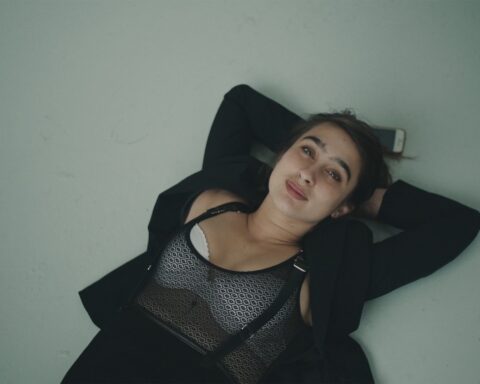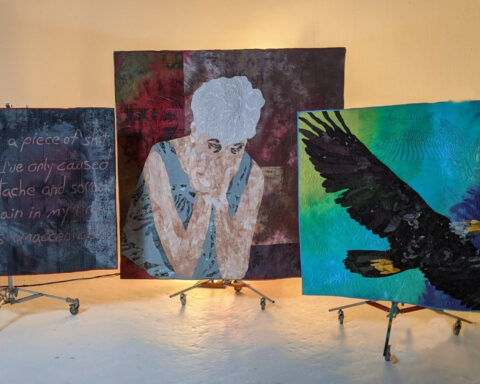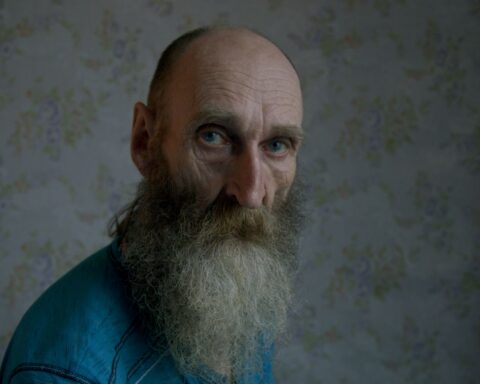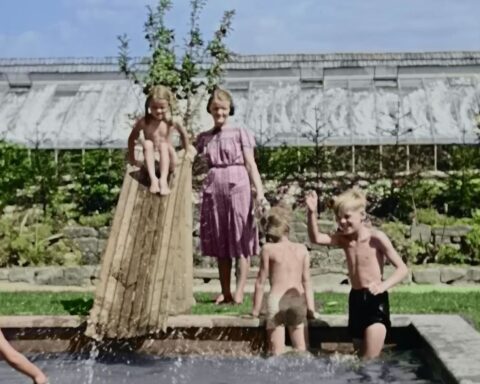Nuit Blanche is a city-wide spectacle of art that has successfully transformed Paris since 2002. Galleries, libraries, museums, store fronts and even swimming pools have stayed open one “sleepless, white night” a year to exhibit installations, videos, painting, sculpture, music—the whole range of art practice. In 2006, Toronto launched its own Nuit Blanche to overwhelming accolades.
The 2007 edition was even more successful in terms of crowd numbers. Over 800,000 people hit the streets last September 29 to experience Nuit Blanche. But what did they see? Was it art or spectacle? Or both?
POV asked video artist Daniel Cockburn and writer-lecturer Jessica Duffin Wolfe to comment on Nuit Blanche. In a “he said/she said” format, each wrote a short essay, then sent it to the other for a response. Their dialogue, we suggest, illuminates the on-going debate surrounding this cultural event.
Attention Deficit
by Daniel Cockburn
It’s the boon and the curse of an event like Nuit Blanche that it seeks to bridge the divide between contemporary art and the public by making art more accessible. Not a bad message to endorse: art is not nearly as self-obfuscating or elitist as you think; it can be generous and inviting, and sure, some of it requires work and “being in the know,” but that work and knowledge are worth it.
This may seem like a unified message but in actuality it’s divided, and if Nuit Blanche goes for “it’s easier than you think” more than “hard stuff is worth it,” should we be surprised? It’s perhaps inevitable that presenting so many artworks in one night implies assurance that any one of them can be digested in 30seconds before moving on to the next.The extent to which exhibits as hyperbolically crammedas Nuit Blanche resemble tradeshows parallels the extent to which art intersects with R&D, the increasing width of the grey zone between autonomous creativity and advertising “creative.” All this is of particular import for artists working with the moving image, a medium which depends on time and viewer attention.
In the case of interactive works, quick apprehension can be greased by elision of content, focus on the technology. Judith Doyle’s Long Crescent House Transformer presented a 26-screen surroundathon of Doyle’s family homeon Second Life (a 3D online virtual world), navigable via a huge trackball. If I failed to encounter meaning in my virtual travels, was it due to my own inadequacy as a user? The work itself certainly harboured no visible tendencies towards expression; perhaps my mistake was to look for it in the first place.
For those artists making moving-image installations, which have neither interactivity nor gadgetry as their calling card, the challenge is to make the work multi-use so that it rewards viewing at length yet also satisfies a cursory view. The moving image in continuous-screening gallery format is always, like it or not, a carny hawker whose wares are itself. In this part-must-speak-for-the-whole situation, the merging of art and advertising is quietly sublimated.
Chiho Aoshima’s City Glow (7minutes,video),a superwidescreen three-projection animation, tack-led this problem with a formalist integrity. Its slow zoom back through fantastically detailed cityscapes and nature worlds was consistent enough that the viewer who only stayed for 20 seconds had a full understanding of how it went (i.e. her assumption that the zoom continued to continue was correct) but the viewer who stayed for seven minutes would be taken on a journey of discovering where.
Millie Chen’s Watcher dealt with the problem of attention by embracing it. A series of magic-lantern shadowplays in the windows of D’Arcy St. homes, its very nature was to catch the eye and make you want to see more. The irony was that Watcher_’s strangeness, its voyeuristic appeal, would have had far greater impact on any other night. I would have preferred encountering these spectral silhouettes by accident, without explanation, rather than as part of a huge crowd roving the street in search of surprise. _Watcher at Nuit Blanche was made by its context into an ad for what Watcher could be.
At first glance, Adad Hannah seemed to be hedging his bets as much as anyone; his Traces were still images, and what could be more instantly apprehensible? But no, they were actually video captures: tableaux posed as still as humanly possible in lo-fi freeze-frame performances. Instant first impressions; perfunctory inspection rewarded with a punchline: prime candidate for Nuit Blanche? Yes,but once the punchline was delivered it wasn’t over; it lasted exactly as long as the viewer wanted it to, and with time you could see the details, minute and human: how their hair wafted, or her hand couldn’t quite stay still on top of his. It is true that the work still did not require long and/or focused attention to work, and as such was both engaging art and billboard-ready technique. But anything else would have a difficult time surviving at Nuit Blanche, just as it does in the day-to-day jockeying for attention of which Nuit Blanche is a sadly accurate microcosm.
Diversity and depth are often inversely proportional—as are audience size and personal impact. To say so may veer dangerously close to elitism. But to pretend otherwise is to contribute to an art environment that mirrors its surrounding audiovisual scape a little too closely; if the loudest, snappiest one-liners get the most ears, this makes for a rollicking night but what of the morning after?
The Natural History of Nuit Blanche by Jessica Duffin Wolfe
It’s impossible to write an honestly objective overview of Nuit Blanche since the event depends so much on individual experience: what you got to see given the constraints of geography, what a wave of fatigue at one in the morning kept you from seeing, what the urgency of your longing for the ultimate berry pressed you towards at 5:00 a.m. Like a giant visual scavenger hunt, Nuit Blanche asks each gallery goer to search for, if not find, an ultimate berry.
Berries in my basket by 7:00 a.m. on September 30th included: a pink-wrapped building, a giant fish swimming in a storefront, electro-acoustic groans emanating from the abandoned Upper-Bay subway station, a boutique hotel room in a dumpster, projections on the angled glass walls of the ROM, a lone saxophonist serenading the multicoloured stems of OCAD, DJs leaning out over a crowd from a makeshift balcony on the Drake Hotel, a car in Kensington covered in signatures, bodies lying on the floor of a church staring through incense, cello music and a hurdy-gurdy at a video on the ceiling, a fake plane crash at U of T ,six people dancing one tango while carrying their own stereo, and a crowd in a gallery at four in the morning. During Nuit Blanche, everyone makes their own show, and so everyone wakes up the next morning a curator. The most moving works get buoyed up and bounced around in conversations, reviewed and relived in snippets on Youtube for months afterwards in a collective catalogue.
If there could be one star of the evening it would be the cell phone, the tool that makes roving over an entire nighttime city an easy feat, since with it gallery goers can disperse on a whim and then find their friends again later, or send around and collect reconnaissance about the best spots. Bicycles shooting through the dark streets painted a picture of the swarms of text messages traveling through crowds. Teilhard de Chardin’s notion of the noosphere, a technologically enabled collective consciousness that he believed would culminate evolution, seemed a step closer. The only blemish in this mobile utopia was the only project I saw that specifically referenced cell phones. Kiosks painted in larger than usual “Scotiabank Nuit Blanche” branding prompted users to send text messages to an official number for display on screens around the city. The messages I saw were boring: “I love u! ”or “marry me cindy!” Toronto seemed to be a happy Whoville where no one had
anything really pungent to say. Wanting to bring a little noir to all this blanche, I texted in a Joseph Brodsky quotation: “In true tragedy, it is not the hero who dies but the chorus.” Moments later I received a pre-programmed reply: “Thank you! If approved your message will show on screen shortly.” Aha, I thought, and sent another text: “Scotiabank Censor makes Toronto proud.” Neither of my messages ever made it on to the screens.
While Scotiabank has rightly been criticized for branding Nuit Blanche too heavily, and Globe and Mail columnists Russell Smith and Sarah Milroy took issue with the crowds and the lack of high-class expensive art, the main and unimpeachable gift of the evening is the opportunity to mingle in thousands under a common, carnivalesque banner of delight. Drawing equally on the vigil and the masquerade, the all night art party sends identity on a joy ride, a race against sunrise and exhaustion, and, for one night, replaces dreams with a fantastical version of the city. Pedestrians triumph over drivers who can’t get parked, and dark empty streets are filled and lit. As the toll of 4:00 a.m. gives the struggle to persevere among hordes of compatriots drama worthy of the Grecian stage, each face that floats out on its own from the crowd registers as a curated artwork.The admonishment to carpe diem that is Nuit Blanche’s best delivery wells up in the crowds’ devotion to the fleeting possibilities of the evening. The white night is a carnival for Toronto, a modern festival that forges new rituals each year in every work of art.
Daniel’s response to Jessica
The cell phone project which Jessica cites is the problem in a nutshell. It was the night’s most extreme but by no means lone example of “insert content here” art—and strangely not even the only text-your-message-to-this-screen artwork at Nuit Blanche 2007, sharing that honour with Nina Czegledy, Greg Judelman, and Daniel Barber’s What Will You Do?
The old-fashioned notion of a one-way meaning street from artist to audience has supposedly been subverted by interactivity, but in too many cases it’s simply been reversed. Now the artist’s role is merely to provide the framework, and the onus is on the audience (or “user”) to decide what the work is actually about, to supply not just perception and interpretation but the object of perception and interpretation as well.
Is this all we ask of our artists? To show us a Rorschach blot and then run away, leaving us a tape recorder and a megaphone to record and broadcast our responses? I look to art to see the evidence of choices having been made, a thousand Yeses combining into a singular work. And though we may want to pretend otherwise, each Yes can only come about con- currently with a thousand Nos. This brand of audience-supplied-content art is not about saying “no.” Nor is Nuit Blanche.
Once all the voices have shouted each other down, what are we left with? The piece’s ulti- mate effect is a celebration and a normalization of its constitutive communications technology: the cell phone. Whether or not the piece bears the brand of a specific phone company is beside the point. It’s a perfect and functioning ad for the idea of the cell phone industry, presented in this case as an enabler of community, implying that to lack a cell phone is to lack engagement in this community.
I fear that the “everybody is a curator” scenario, its jubilance undeniable, is just a larger version of the “everybody is an artist” scenario; that this presentation format en- courages this style of artwork, and vice versa. Making the experience a blank slate may seem like generous empowerment, but it plays to the assumption that art is as easily engaged and as easily forgotten as a video game. I would rather have someone provide me with something to respond to. The object is up to them, the response is up to me; I don’t know if that’s interactivity but it’s genuine interaction.
Jessica’s Response to Daniel
It’s because of the failures in Nuit Blanche that Daniel points out that I’ve come to regard the crowds as the main event and installation of the evening. I wasn’t disappointed that the impact of the art—the declared motive of the evening—was muted by the crowds since I realized that Nuit Blanche must be some- thing more than a city-wide gallery show. No sophisticated artwork can really garner the attention it deserves from a distracted moving audience of tens of thousands. And yet, taken collectively these brief glimpses, snapshots of “creative” thinking give Toronto an excuse to congregate.
Of course time-based works would be more enjoyable, more easily attended to in the comfort of one’s own home, or in a deep plush theatre chair, but the most important time-based work of the evening is the 12 hours of the night itself. No one can fail to be a good user or viewer of that audiovisual show, since the only challenge is to show up with an open mind and then follow one’s nose. And they do: people come to expose themselves to the art, to be changed, perhaps, or just, as Daniel says, surprised. As he suggests, the night is a kind of creative thinking trade show, a prototype of its own possibilities, but if mass culture and industry find it more welcoming than do the paragons of avant-garde art, then perhaps that is a success to be celebrated.
The more opportunities there are for surprising, artful ideas to circulate among those holding financial power and representing consumer interests, the more efficiently our society will be able to tackle its problems. The very impression given by Nuit Blanche of a massive collectivity in pursuit of a common vaguely frivolous desire to be surprised by art can only help but further a city-wide impression of Toronto as a community that can work together towards altruistic goals. Peering too closely at any individual artwork is like putting too much pressure on one tiny joint in a giant fleeting dinosaur skeleton of a magical evening. Nuit Blanche isn’t about art. It’s about people.











